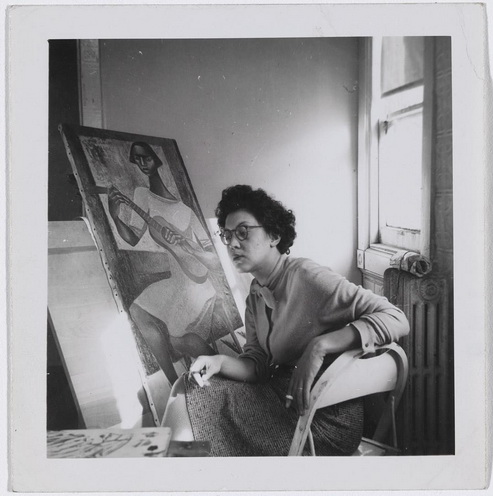 Charles White. Elizabeth Catlett in her studio. c. 1942. (9.2 × 9 cm). Private collection. © The Charles White Archives |
Elizabeth Catlett | |
| Birth Date: April 15, 1915 |
||
| Death Date: April 2, 2012 Artist Gallery |
||
| Artist-activist Elizabeth Catlett was born on April 15, 1915 in Washington D.C. At the time, the United States was still very much racially segregated. As an African-American woman and with both sets of her grandparents having been previously enslaved, Catlett was aware of racism and other social issues from an early age.
Having been rejected from the Carnegie Institute of Technology on the basis of her race, Catlett chose to study art at Howard University, starting in 1931. After graduating with her bachelors, she briefly led an elementary school arts program in Durham, North Carolina. She left this position when she chose to pursue her masters studies at the University of Iowa. While at the university, Catlett studied under the famed Regionalist, Grant Wood. Wood encouraged his students to focus on subjects that they knew the most about. As such, it is not surprising that a bulk of Catlett’s work centers around African American women and motherhood. At the time of her graduation, she was the first female to earn an MFA in sculpture from the University of Iowa.
In 1940, Catlett met fellow artist Charles White while in Chicago. The pair went on to marry and move to New Orleans the following year, before relocating to Harlem, New York. While in Harlem, Catlett studied lithography and modernist sculpture at the Art Students League. Here, she met a founder of El Taller de Grafica Popular, an art collective in Mexico that would greatly impact her later life.
In 1945, she received a grant from the Rosenwald Foundation and traveled to Mexico. When she arrived in Mexico, Catlett was deeply influenced by Mexican muralists and the sociopolitical artists at El Taller de Grafica Popular. By 1947, she had permanently relocated to Mexico and divorced Charles White. She remarried to another artist, Francisco Mora, with whom she had three sons. Though she was in Mexico, Catlett remained concerned with the Civil Rights movement and social issues of her birth country. Due to the political nature of her work and perceived communist affiliations, Catlett was barred from entering the United States following an investigation by the House Committee of Un-American Activities. She officially became a citizen of Mexico in 1962 and her US citizenship was not reinstated until 2002.
She revisited education, teaching at the National School of Fine Arts in Mexico City for 18 years. Throughout her life, Catlett also taught at Dillard University, George Washington Carver School, and the National Autonomous University of Mexico.
She continued to create art about what she knew best: womanhood, motherhood, and disadvantaged groups. Her work not only calls attention to sociopolitical issues, but also showcases the strength and struggles of the individuals that endure them. Catlett believed “...that art should come from the people and be for the people.” After an impressive career with many exhibitions and solo shows, she was awarded the Lifetime Achievement Award from the International Sculpture Center in 2003.
|
||


